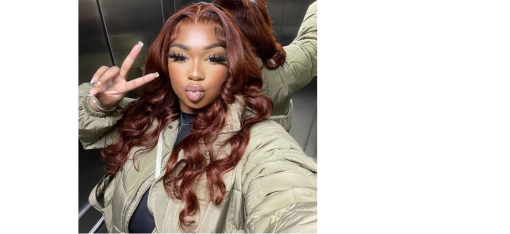How to Wear a Lace Front Wig with Glue: A Complete Guide for a Flawless Look
Lace front wigs have revolutionized the world of hairstyling, offering versatility and natural-looking results. Wearing a lace front wig with glue ensures a secure and seamless fit. In this comprehensive guide, we'll take you through each step, from preparing your hair and skin to styling and caring for your wig. Discover the art of flawless wig application and unleash your creativity with stunning hairstyles.
I. Preparing Your Hair and Skin
Make Your Natural Hair Flat: Before applying a lace front wig, it's crucial to ensure your natural hair lies flat to achieve a smooth and seamless look. To start, wash your hair using a gentle shampoo and conditioner. Opt for products that won't leave residue or make your hair greasy, as this can affect the adherence of the wig. Rinse thoroughly to remove all product buildup.
After washing, it's best to blow-dry your hair or use a flat iron to achieve a sleek, flat foundation. Comb your hair straight and ensure there are no tangles or knots. By creating a flat base, you'll provide a better surface for the wig to adhere to, resulting in a more natural appearance.
Keep Your Hairline Clean: A clean hairline is essential for a seamless wig application. Take the time to gently cleanse your forehead and hairline using a mild cleanser or facial wipe. This step removes any oils, dirt, or makeup that may be present, ensuring optimal adhesion of the wig. Pay extra attention to the areas where the wig will sit, such as along the hairline and temples.
After cleansing, pat your skin dry with a clean towel. It's important to ensure your skin is free from excess moisture, as it can interfere with the bonding process. If you have naturally oily skin, you may want to consider using a gentle toner to further remove any residual oils.
Wear a Wig Cap: To further secure your natural hair and create a smooth base for the wig, wearing a wig cap is highly recommended. A wig cap not only helps keep your hair in place but also prevents the wig from shifting or slipping. Choose a cap that closely matches your skin tone for a more seamless blend.
To wear a wig cap, start by brushing your hair backward and away from your face. Place the wig cap over your head and adjust it so that it covers your entire hairline, from forehead to nape. Ensure that all of your natural hair is tucked within the cap, using bobby pins if necessary to secure any loose strands. Smooth out any bumps or lumps in the cap to create a flat and even surface.
By preparing your hair and skin properly, you'll set the stage for a successful lace front wig application. Creating a flat base, keeping your hairline clean, and wearing a wig cap will enhance the overall look and ensure a secure and comfortable fit for your wig. Now that you've prepped your hair and skin, let's move on to the next step: choosing the right glue for your lace front wig application.
II. Choosing the Right Glue
Different types of wig glue are available in the market, each with its own unique properties. When selecting the glue that suits you best, it's important to consider several factors to ensure a secure and comfortable hold for your lace front wig.
Hold Strength: One of the key considerations when choosing wig glue is the hold strength. Wig glues range from light hold to strong hold options. Light hold glues are suitable for daily wear and offer flexibility, making it easier to remove the wig. On the other hand, strong hold glues provide a more secure and long-lasting bond, making them ideal for special occasions or extended wear. Assess your needs and preferences to determine the level of hold that works best for you.
Drying Time: The drying time of the glue is another crucial aspect to consider. Some glues dry quickly, while others take a bit longer to set. If you're a beginner or prefer more time for adjustments during the application process, opting for a slower-drying glue might be beneficial. However, if you're experienced and prefer a faster application, a quick-drying glue could be a suitable choice. Keep in mind that following the manufacturer's instructions regarding drying time is essential for achieving the best results.
Skin Sensitivity: Before applying any glue to your skin, it's crucial to consider your skin's sensitivity. Different individuals may have varying reactions to wig glues, so it's recommended to perform an allergy test prior to application. Apply a small amount of the glue on a patch of skin, such as the inside of your wrist or behind your ear, and leave it for 24 hours. If you experience any redness, itching, or irritation during this time, it's advisable to choose a different glue or consult with a dermatologist.
High-Quality Adhesive: To ensure a reliable and long-lasting hold, it's essential to invest in a high-quality adhesive specifically designed for lace front wigs. These adhesives are formulated to provide a strong bond while remaining gentle on the skin. They are often water-resistant and can withstand various environmental conditions, such as humidity and perspiration. Opting for a reputable brand and reading reviews from other wig wearers can help you choose a reliable and effective glue for your lace front wig.
Performing an Allergy Test: Performing an allergy test is a crucial step before applying the glue to your skin. Even if you have used wig glues before, it's important to retest each time you switch to a new brand or formulation. To perform the test, apply a small amount of the glue on a small area of skin as mentioned earlier. Monitor the test area for any adverse reactions such as redness, swelling, or itching. If you experience any negative reactions, discontinue use of that particular glue and seek alternatives that are better suited for your skin.
By considering factors such as hold strength, drying time, and skin sensitivity, you can choose the right glue for your lace front wig application. Remember to opt for high-quality adhesives and perform an allergy test to ensure a secure and comfortable fit. With the right glue, you'll be on your way to achieving a flawless and long-lasting hairstyle.
III. Applying the Glue
Trim the Extra Lace: Before applying the wig glue, it's important to trim the excess lace along the front edge of the wig. This excess lace can interfere with the natural appearance and fit of the wig. Using sharp scissors, carefully trim the lace, following the shape of your natural hairline. Take your time and make precise cuts to achieve a seamless and natural look. It's advisable to trim small sections at a time to avoid cutting too much lace. Remember, it's better to trim conservatively and make adjustments later if needed.
Apply Wig Glue: Once you've trimmed the excess lace, it's time to apply the wig glue. Start by preparing the area where you'll be applying the glue. Cleanse your forehead and hairline once again to remove any oils, dirt, or residue that may have accumulated. This step ensures optimal adhesion.
Next, apply a thin and even layer of wig glue onto the lace front using a brush or applicator. Begin from the middle of the wig and work your way out towards the edges, ensuring the glue is applied close to the hairline. Take care to avoid getting the glue on your natural hair, as this can cause damage and make it difficult to remove the wig later. If you accidentally get glue on your hair, gently wipe it off with a damp cloth or cotton swab before it dries.
It's important to note that a little goes a long way when it comes to wig glue. Applying too much glue can result in a messy and uncomfortable application. Start with a thin layer, and if needed, you can always add more later. Allow the glue to sit for a moment to become tacky, as this helps ensure a strong and secure bond between the lace and your skin.
Blow Dry Wig Glue: To speed up the drying process and enhance the tackiness of the glue, you can use a blow dryer on a low or cool setting. Hold the blow dryer at a distance and gently blow-dry the glued area until the glue becomes tacky to the touch. Avoid using high heat settings, as excessive heat can damage the lace or your skin.
The tackiness of the glue is essential for a secure and long-lasting bond. It allows the lace to adhere firmly to your skin, providing a natural-looking hairline and preventing the wig from shifting or lifting. Be patient during this step and avoid touching the glued area until the glue has fully dried and become tacky.
By carefully trimming the excess lace, applying a thin and even layer of wig glue, and using a blow dryer to dry the glue until tacky, you're ensuring a secure and comfortable fit for your lace front wig. The next step is to move on to gluing your lace front wig down, which we'll cover in the next section.
Note: Always refer to the manufacturer's instructions and guidelines when applying wig glue, as different brands may have specific recommendations for application and drying times.
V. Gluing Your Lace Front Wig Down
Aligning the Wig with Your Natural Hairline: With the lace front wig prepared and the glue applied, it's time to position the wig on your head. Align the front edge of the wig with your natural hairline, ensuring it sits securely and comfortably. Take your time to adjust the wig's placement, making sure it looks symmetrical and balanced on your head. Use a mirror to help you achieve the desired alignment. It can be helpful to lightly mark the position of the wig with a removable eyeliner or chalk to guide you during the application process.
Gently Pressing the Lace onto the Glued Area: Once you've aligned the wig with your natural hairline, it's time to secure the lace onto the glued area. Starting from the center, gently press the front edge of the lace onto the glue, gradually working your way outwards towards the sides. Use a clean, dry towel or your fingertips to firmly press the lace onto the glued area. The pressure applied helps the lace adhere securely to your skin, creating a seamless and natural transition between the wig and your own hairline.
Pay attention to any wrinkles or air bubbles that may appear as you press the lace down. Smooth them out gently to ensure a smooth and natural appearance. If you encounter any stubborn wrinkles or air bubbles, you can carefully lift the lace and reposition it, applying more pressure to smooth it out. Take your time during this process to achieve the desired result.
Get Rid of Extra Glue: Sometimes, excess glue may seep out from the edges of the lace. This can happen due to overapplication or the pressure applied during the securing process. It's important to remove any excess glue promptly to maintain a clean and natural look.
To remove excess glue, use a cotton swab or a soft, damp cloth. Gently dab the cotton swab or cloth on the affected areas, carefully lifting away the excess glue. Avoid pulling or tugging on the lace, as this may displace it or cause damage. Be gentle and patient when removing the excess glue, taking care not to disturb the placement of the wig.
Removing excess glue not only enhances the appearance of the lace front wig but also prevents it from feeling uncomfortable or stiff against your skin. Once you've removed the excess glue, allow the glued area to dry completely before proceeding with styling or further adjustments.
By aligning the wig with your natural hairline, gently pressing the lace onto the glued area, and removing any excess glue, you're ensuring a secure and seamless attachment of your lace front wig. The next section will cover securing your lace front wig for a comfortable and confident fit.
V. Securing Your Lace Front Wig
Adjusting the Wig for a Secure and Comfortable Fit: After gluing down the lace front wig, it's important to make sure it fits securely and comfortably on your head. Most lace front wigs come with adjustable straps and hooks located at the back of the wig cap. These features allow you to customize the fit according to your head size and shape.
To adjust the wig, start by locating the adjustable straps. Hold the wig securely and find the straps near the nape of the wig cap. Depending on the design, there may be one or two straps. Hold the straps and gently pull them to loosen the wig cap. Place the wig on your head and align it with your natural hairline.
Next, tighten the straps by pulling them towards the back of your head. Be careful not to over-tighten, as it may cause discomfort or strain on your scalp. The wig should feel snug but not too tight, allowing you to move your head comfortably without the fear of the wig shifting or coming off. Once you have achieved the desired fit, secure the straps in place using the hooks or fasteners provided.
Remember to adjust the wig cap evenly on both sides for a balanced and natural look. Take your time to ensure the wig feels secure and comfortable. If necessary, you can also use bobby pins to further secure the wig at the sides or back for added stability.
Style Your Lace Front Wig:
Now that your lace front wig is securely in place, it's time to get creative and style it according to your preferences. Lace front wigs offer versatility and allow you to experiment with various hairstyles. Here are some popular hairstyles you can try:
-
Updos: Create elegant updos by gathering your wig's hair into a ponytail or bun. Secure the hair with hair ties or bobby pins, ensuring a polished and sleek look. You can also leave some strands loose for a softer and romantic updo.
-
Curls: To achieve beautiful curls, use a curling iron or hot rollers. Select a heat setting that is appropriate for the wig's synthetic or human hair type. Take small sections of hair and wrap them around the curling iron or hot roller, holding for a few seconds before releasing. Continue curling the entire wig, and then use your fingers or a wide-toothed comb to gently separate and arrange the curls for a natural appearance.
-
Braids: Experiment with braided hairstyles such as French braids, Dutch braids, or fishtail braids. Divide the wig's hair into sections and follow the desired braiding technique. Secure the ends with hair ties or bobby pins. You can leave the braids as they are or incorporate them into other styles, such as updos or half-up hairstyles.
-
Sleek Straight Look: For a sleek and straight hairstyle, use a flat iron to smooth out any waves or curls. Start with small sections of hair and run the flat iron down each section, keeping the iron moving smoothly to avoid heat damage. Finish by applying a small amount of anti-frizz serum or hair spray to maintain the sleek look.
When styling your human hair wig, work in small sections, gently combing through the hair to remove any tangles or knots. Then, using your heat styling tool, curl or straighten the hair as desired, holding each section for a few seconds before releasing. Use a wide-toothed comb or a wig brush with soft bristles to gently detangle the hair. Start from the ends and work your way up, being careful not to pull on the lace or the hair strands. Holding the wig from the cap while combing or brushing can provide additional support and prevent any unnecessary stress on the lace front.
When not wearing your human hair wig, store it properly to prevent tangling and damage. Keep it in a wig stand or on a wig head to maintain its shape and prevent the hair from becoming matted. It's also a good idea to cover the wig with a satin or silk scarf or place it in a wig bag to protect it from dust and other environmental factors.
By following these guidelines for heat styling and proper maintenance, you can enjoy a long-lasting and beautiful human hair wig without compromising its quality or appearance.
Stay tuned for our next blog: How to Wear a Lace Front Wig Without Glue. In the upcoming blog, we'll explore alternative attachment methods that provide a secure fit while allowing for easy removal and versatility. Learn about wig clips, combs, adjustable straps, and more. Don't miss out on expanding your lace front wig repertoire!
Conclusion:
Wearing a lace front wig with glue opens up a world of possibilities for flawless hairstyles. By following the detailed steps in this guide, you'll achieve a secure and natural-looking fit that lasts. Experiment with different wig styles, colors, and textures to express your unique personality. Stay confident, embrace your beauty, and get ready to turn heads with your stunning lace front wig.












Leave a comment